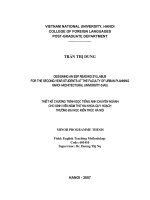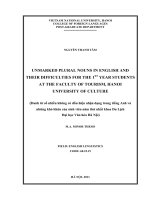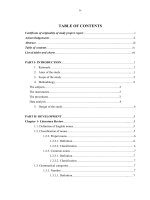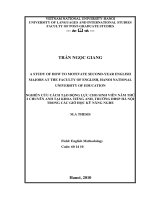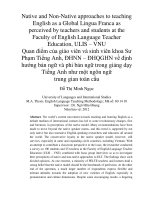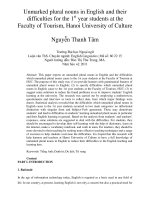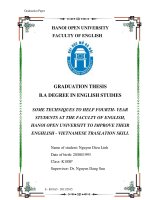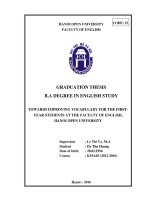Some techniques to help fourth year students at the faculty of english, hanoi open university to improve their english vietnamese translation skill
Bạn đang xem bản rút gọn của tài liệu. Xem và tải ngay bản đầy đủ của tài liệu tại đây (564.26 KB, 65 trang )
Graduation Paper
HANOI OPEN UNIVERSITY
FACULTY OF ENGLISH
GRADUATION THESIS
B.A DEGREE IN ENGLISH STUDIES
SOME TECHNIQUES TO HELP FOURTH- YEAR
STUDENTS AT THE FACULTY OF ENGLISH,
HANOI OPEN UNIVERSITY TO IMPROVE THEIR
ENGHLISH - VIETNAMESE TRASLATION SKILL
Name of student: Nguyen Dieu Linh
Date of birth: 20/08/1993
Class: K18SP
Supervisor: Dr. Nguyen Dang Suu
Nguyen Dieu Linh - K18A3 - 2011/2015
Graduation Paper
Hanoi - 2015
ACKNOWLEDGEMENTS
First of all, I wish to express my deepest gratitude to my supervisor, Dr.
Nguyen Dang Suu, for his academic guidance and support throughout this study.
Without his valuable assistance, my thesis would not have been completed.
I would like to sincerely thank the lecturers of Faculty of English, Hanoi
Open University who have provided me with not only knowledge but also the
study condition during my student life, as well as their useful advice in this
graduation paper.
I would also like to extend my thanks to 100 fourth-year students of
Faculty of English, Hanoi Open University for their aid in implementing survey.
Finally, I am indebted to my family and friends who have encouraged and
supported me so much in the completion of this paper. If there had not been great
help from the above people, the study could not have been fulfilled.
Hanoi, 2nd May, 2015
Nguyen Dieu Linh
Nguyen Dieu Linh - K18A3 - 2011/2015
Graduation Paper
TABLE OF CONTENTS
Some Techniques to Help Fourth-year Students at the
Faculty of English, Hanoi Open University to Improve
Their English - Vietnamese Translation Skills
PART A: INTRODUCTION........................................................................ 1
1. Rationale ................................................................................................... 1
2. Aims and Purposes of the study .............................................................. 2
3. Scope of the study ..................................................................................... 2
4. Research questions .................................................................................... 2
5. Methods of the study ................................................................................. 2
6. Design of the study .................................................................................... 3
PART B: DEVELOPMENT......................................................................... 5
CHAPTER I: LITERATURE REVIEW .................................................... 5
1.1. An overview of translation .................................................................. 5
1.1.1. The definition of translation ............................................................... 5
1.1.2. The principles of translation............................................................... 5
1.2. Methods of translation. ...................................................................... 14
1.2.1. Semantic translation ..................................................................... 14
1.2.2. Communicative translation........................................................... 15
1.2.3. Word-for-word translation............................................................ 17
1.2.4. Literal translation ......................................................................... 17
1.2.5. Faithful translation ...................................................................... 18
1.2.6. Transliteration ............................................................................... 19
1.2.7. Calque ............................................................................................ 19
1.2.8. Adaptation ..................................................................................... 20
1.2.9. Descriptive translation .................................................................. 20
1.2.10. Free translation ........................................................................... 20
1.2.11. Idiomatic translation ................................................................... 21
Nguyen Dieu Linh - K18A3 - 2011/2015
Graduation Paper
CHAPTER II: SOME COMMOM MISTAKES MADE BY FOURTHYEAR STUDENTS IN ENGLISH - VIETNAMESE TRANSLATION 22
2.1. Subjects of the study ........................................................................... 22
2.2. Data collection method ........................................................................ 22
2.2.1. Questionnaires............................................................................... 22
2.2.2. Interview ........................................................................................ 23
2.2.3. Translation test .............................................................................. 23
2.3. Findings ................................................................................................. 24
CHAPTER III: SOME SUGGESTIONS FOR IMPROVING FOURTHYEAR STUDENTS’ ENGLISH - VIETNAMESE TRANSLATION SKILL
AT FACULTY OF ENGLISH, HOU ........................................................ 32
3.1. Background knowledge ......................................................................... 32
3.2. Grammar................................................................................................ 37
3.3. Vocabulary ............................................................................................. 46
PART C: CONCLUSION........................................................................... 50
REFERENCES ......................................................................................... 52
APPENDIX .................................................................................................. 54
Nguyen Dieu Linh - K18A3 - 2011/2015
Graduation Paper
LIST OF ABBREVATIONS
Etc
: Et cetera
HOU : Hanoi Open University
SL: source language
TL: targer language
LISTS OF FIGURES AND TABLES
Table 1: Students‟ attitudes toward learning translation
Table 2: Students‟ learning translation problems
Table 3: Student‟s understand of translation learning
Table 4: Student‟s common ways in translation
Table 5, 6 and 7: Student‟s performance in their learning English- Vietnamese
translation
Table 8: Students‟ comment on teacher‟s method and their expectation
Table 9: Result of translation test (percentage of incorrect answers)
Nguyen Dieu Linh - K18A3 - 2011/2015
Graduation Paper
PART A: INTRODUCTON
1. Rationale
The 21st century has experienced the boom of globalization as people all
around the world have connected successfully to each other without the
boundary of any country. Being the tool to communicate of most people, English
now plays an essential role in the development progress of human beings as an
international language of the whole world. Therefore, mastering English is the
desire of many students to have better opportunities to get a better job in future.
In Vietnam as well as other countries, English has been taught for many years
and become a compulsory subject at any level of education. Pupils are required
to expert in simple and basic skills of English such as listening, writing, reading,
speaking after graduating high school.
However, at academic study level, especially at Faculty of English, Hanoi
Open University, students are demanded not only to be good at basic skills but
also to understand English deeply and use them efficiently to become a
professional translator. Hence, good English - Vietnamese translation skill is one
of the most major achievements of all students studying academic English.
In this study, I would like to carry out a study on how fourth-year students at
the Faculty of English, Hanoi Open University are learning English- Vietnamese
translation in order to find out their difficulties, to work out the causes, and then to
suggest some solutions to deal with these problems. Therefore, I decided to
choose the topic "Some Techniques to help fourth- year students improve their
English- Vietnamese translation skill at Faculty of English, Hanoi Open
University ".
Nguyen Dieu Linh - K18A3 - 2011/2015
1
Graduation Paper
2. Aims and objectives of the study
Giving a brief overview of translation and how fourth-year students at
Faculty of English, HOU are learning English - Vietnamese translation.
Finding out difficulties and mistakes made by fourth-year students at
Faculty of English, HOU in learning English - Vietnamese translation.
•
Giving suggested solutions to learn English - Vietnamese translation
effectively.
3. Scope of the study
The study limits itself to the investigation of the difficulties and their causes of
the fourth-year students at Faculty of English, HOU in learning English Vietnamese translation. The solutions are provided to help fourth-year students at
the Faculty of English, HOU learn English - Vietnamese translation more
effectively
4. Research questions
What are the common mistakes made by fourth-year students at Faculty
of English, HOU in the process of learning English - Vietnamese translation?
•
What are some suggestions for fourth-year students to improve their
English - Vietnamese translation skill?
5. Methods of the study
In this study, I use such methods as descriptive method, questionnaires,
quantitative and qualitative, translation test and interviews. The combination
helps to provide the most exact result for the research about learning English Vietnamese translation at Faculty of English, HOU.
6. Design of the paper
Nguyen Dieu Linh - K18A3 - 2011/2015
2
Graduation Paper
TABLE OF CONTENTS
Some Techniques to Help Fourth-year Students at the
Faculty of English, Hanoi Open University to Improve
Their English - Vietnamese Translation Skills
PART A: INTRODUCTON
1. Rationale
2. Aims and Purposes of the study
3. Scope of the study
4. Research questions
5. Methods of the study
6. Design of the study
PART B: DEVELOPMENT
CHAPTER I: LITERATURE REVIEW
1.1. An overview of translation
1.1.1. The definition of translation
1.1.2. The principles of translation
1.2. Methods of translation.
1.2.1. Semantic translation
1.2.2. Communicative translation
1.2.3. Word-for-word translation
1.2.4. Literal translation
Nguyen Dieu Linh - K18A3 - 2011/2015
3
Graduation Paper
1.2.5. Faithful translation
1.2.6. Transliteration
1.2.7. Calque
1.2.8. Adaptation
1.2.9. Descriptive translation
1.2.10. Free translation
1.2.11. Idiomatic translation
CHAPTER II: SOME COMMOM MISTAKES MADE BY FOURTHYEAR STUDENTS IN ENGLISH - VIETNAMESE TRANSLATION
2.1. Subjects of the study
2.2. Data collection method
2.2.1. Questionnaires
2.2.2. Interview
2.2.3. Translation test
2.3. Findings
CHAPTER III: SOME SUGGESTIONS FOR IMPROVING FOURTHYEAR STUDENTS’ ENGLISH - VIETNAMESE TRANSLATION SKILL
AT FACULTY OF ENGLISH, HOU
3.1. Background knowledge
3.2. Grammar
3.3. Vocabulary
Nguyen Dieu Linh - K18A3 - 2011/2015
4
Graduation Paper
PART C: CONCLUSION
REFERENCES
APPENDIX
Nguyen Dieu Linh - K18A3 - 2011/2015
5
Graduation Paper
PART B: DEVELOPMENT
CHAPTER I: LITERATURE REVIEW
1.1. An overview of translation
1.1.1. The definition of translation
What is translation? Often, though not by any means always, it is rendering
the meaning of a text into another language in the way that the author intended
the text. Common senses tell us that it ought to be simple, as one ought to be
able to say something as well in one language as in another. On the other hand,
you may see it as complicated, artificial and fraudulent, since by using another
language you are pretending someone you are not. Hence in many types of text
(legal, administrative, dialect, local, cultural) the temptation is to transfer as
many SL (Source Language) words to the TL (Target language) as possible. The
pity is, as Mounin wrote, that the translation can not simply reproduce, or be, the
original. And since this is so, the first business of translation is to translate.
1.1.2. The principles of translation
There are some general principles which are relevant to all translation:
1.1.2.1. Meaning
The translation should reflect accurately the meaning of the original text.
Nothing should be arbitrarily added or removed, though occasionally part of the
meaning can be “transposed-changed the position”. For example:
“The real Vietnam War ended in 1975, everything about it since then has
become a war story…” Cuộc chiến thực ở VN đã kết thúc năm 1975…
Nguyen Dieu Linh - K18A3 - 2011/2015
6
Graduation Paper
- “ He made the bed” : the meaning of the sentence must be made clear whether
he put the sheets, blanket and pillow in neat order on the bed or he as a carpenter
made the new bed.
The translator should ask himself:
- if the meaning of the original text is clear, if not where the uncertainty lies.
- if any words are loaded, that is, if there are any underlying implications.
(“Correct me if I am wrong…” suggests “I know I am right”!)
- If the dictionary meaning of a particular word is the most suitable one.
- If anything in the translation sounds unnatural or forced.
As we have seen that one form may express a variety of meanings and on the
other hand, one meaning can be expressed in a great number of forms. For
example, “Is this seat taken?”; “Is there anyone sitting here?”; “May I sit here?”
All have the same meaning: the speaker is indicating a desire to sit in a certain
seat.
Each language has its own distinctive forms for representing the meaning.
Therefore, in translation the same meaning may have to be expressed in another
language by a very different form. To translate the form of one language literally
according to the corresponding form in another language would often change the
meaning or at least result in a form which is unnatural in the second language.
Meaning must, therefore, have priority over the form in translation. It is meaning
which is to be carried over from the source language to the target language, not
the linguistic forms. In addition, a literal translation (word-for-word translation)
does not communicate the meaning of the source text. It is generally no more
than a string of words intended to help someone read a text in its original
language. It is unnatural and hard to understand, and may even quite
Nguyen Dieu Linh - K18A3 - 2011/2015
7
Graduation Paper
meaningless, or give a wrong meaning in the target language. It can hardly be
called a translation. The goal of a translator should be to produce a target
language text (a translation) which is idiomatic; that is one translation which has
the same meaning as the source language but is expressed in the natural form of
the target language. The meaning, not the form is retained.
1.1.2.2. Form
Dealing with the form means referring to the lexicon and grammar of one
language. The ordering of words and ideas in the translation should match the
original as closely as possible. This is particularly important in translating legal
documents, guarantees, contracts, etc…
Translation is basically a change of form (lexicon and grammar). When we
speak of the form of a language, we are refering to the actual words, phrases,
clauses, sentences, paragraphs etc., which are spoken or written. These forms are
referred to as the surface structure of a language. It is the structural part of
language which is actually seen in print or heard in speech. In translation, the
form of the source language is replaced by the form of the target language.
It‟s obvious that translation consists of transferring the meaning of the
source language into the target language. This is realized by going from the form
of the first language to the form of a second one by way of semantic structure. It
is meaning which is being transferred and must be held constant. Only the form
changes. The form from which the translation is made will be called the source
language and the form into which it is to be changed will be called the target
language. Translation, then, consists of studying the lexicon, grammatical
structure, communication situation and cultural context of the source language
text, analyzing it in order to determine its meaning, after that reconstruct this
Nguyen Dieu Linh - K18A3 - 2011/2015
8
Graduation Paper
same meaning using lexicon and grammatical structure which are proper in the
target language and its cultural context.
Let us look at one example that we are translating a Vietnamese sentence
into English:
“Mấy năm qua công cuộc đổi mới trên mặt trận kinh tế của đất nước ta đã
mở ra mạnh mẽ.”
Over the past few years, the economic innovation of our
Qua
mấy năm
kinh tế
đổi mới
country
của ch/ta đất nước
has ushered drastically.
đã
mở ra
mạnh mẽ
It is undoubted that the given example consists of some changes in form:
order of Vietnamese words (SL) in a sentence is different from that of English
(TL). The Vietnamese form consists of the verb form „mở ra-has ushered‟, noun
forms, (đổi mới-innovation, đất nước-country,năm-years); adjective form(kinh
tế-economic); adverb form(mạnh mẽ-drastically).
The fact shows that persons who know both the SL and the TL well can
often make the transfer from one form to the other very quickly, without thinking
about the semantic structure overtly
+ In most languages there is a meaning component of plurality as suffix
„S‟ in English. This suffix often occurs in the grammar on the nouns or verbs or
both.Whereas it does not occur in Vietnamese. It is expressed in terms of
lexicon.
Books in the library have been kept carefully.
Nguyen Dieu Linh - K18A3 - 2011/2015
9
Graduation Paper
Những quyển sách trong thư viện được giữ gìn cẩn thận.
+ The same meaning component can be expressed in several surface
structure lexical items. There is the word „Sheep‟ in English. However, the words
Lamb, ram and ewe also occur and include the meaning Sheep. But these words
get the additional meaning components which are young (in lamb), adult and
male (in ram), and adult and female (in ewe).
+ It should be noted that one form can be used to convey alternative
meanings.Since most words have more than one meaning: the primary meaning
which ussually comes to mind when the word is said in isolation and the
secondary meanings- the additional meanings which a word has in context with
other words. We take the verb „run‟ in English as an example. We can say the
boy runs. Runs here is in its primary meaning. We can also say the car runs, the
river runs and her nose runs. Runs in the given sentences are in its secondary
meanings. It should be borne in mind that the same grammatical pattern may
express several different meanings. We just take the English phrase „my house‟
for example, it may mean “the house I live in”, “the house I built”, “the house I
own”, “the house I rent,”or “the house for which I drew up the plans”. Only the
larger context can determine the particular meaning.
+ The whole sentence may also have several functions. A question form
may be used for a nonquestion. For example, the question “John, why don‟t you
go to the concert?” takes the form of a question, and may be asking for
information in some context, but it is often used with the meaning of a command
(or suggestion) rather than a real question. It is then a real question. A simple
sentence in English like “He made the bed,” may mean either “He (the
Nguyen Dieu Linh - K18A3 - 2011/2015
10
Graduation Paper
carpenter) made the bed,” or “He put the sheets, blanket, and pillow in neat
order on the bed.”
Just for words have primary and secondary meanings, grammatical
markers have their primary function and often have other secondary functions.
Let us take preposition ON for illustration.
- Jane found a book on the table. quyển sách ở trên bàn
- Jane found a book on English. quyển sách về tiếng Anh
- Jane found a book on Thursday quyển sách vào ngày thứ năm
- Jane found a book on sale.
đem ra bán
Or
- Michael was sitting by the riverside: by in this sentence signals that the
Riverside is the location.
- The thief was arrested by a police:
by in this case signals the meaning
that Police is the agent of the action.
1.1.2.3. Register
The term register is used in the same way as „style‟ in the field of
language learning and teaching. It is used to refer to all types of situational
variation and sometimes also to refer to socially-conditioned variation.
Languages often differ greatly in the levels of formality in a given context.
To resolve these differences, the translator must distinguish between
formal/informal or fixed expressions and personal expressions, in which the
writer or speaker sets the tone. The translator should also consider:
- if any expression in the SL would sound too formal/ informal, cold/ warm,
personal/ impersonal…if translated literally. For example:
-Expressing anger:
Nguyen Dieu Linh - K18A3 - 2011/2015
11
Graduation Paper
The slight figure of Maria appeared in the doorway, her eyes flashing,
„You are late, you are late, you are 23 minutes late.‟ Or
„Don‟t you tell me to calm down. You‟d like me to be a drudge, wouldn‟t you, to
be a slave, to keep silent while you go out drinking and chasing girls all the
nights?‟…
-Expressing formal style,
Would you mind leaving us alone for a few minutes?
Would you open the door for me, please?
For example:
- That girl teacher is looking very charming
Cô giáo ấy thì trông rất duyên/ đang trông rất duyên
- Quả táo này ăn rất ngon
- This apple eats very tasty literal / word-for-word translation
Hôm qua đã khai mạc hội chợ thương mại quốc tế tại Hà Nội
Yesterday opened the world trade Fair in Hanoi. Literal translation
- Would you mind my smoking in here? Formal asking for permission
- The translator must find out what the intention of the speaker or writer is. (to
persuade/dissuade, apologize / criticize. If this comes true in translation. For
example:
- Why don‟t we go to the movie tonight? Suggestion
- Would you, please, have another cup of cofee? Invitation
1.1.2.4. Source language influence
One of the most frequent criticisms of translation is that „it doesn‟t sound
natural‟. This is because the translator‟s thoughts and choice of words are too
strongly moulded by the original text. A good way of shaking off the source
Nguyen Dieu Linh - K18A3 - 2011/2015
12
Graduation Paper
language influence is to set the text aside and translate a few sentences aloud,
from memory. This will suggest natural pattern of thought in the first language,
which may not come to mind when the eye is fixed on the SL text.
- …”Chẳng nói chẳng rằng, ba dang tay bợp tai cho nó một cái đánh „bốp‟. Con
bé loạng choạng ngã xuống vũng nước bẩn, nước mắt nó ứa ra, chắc là đau lắm.
Con ráng chạy lại níu tay ba, nhưng không kịp…”
… “Without a word you (held out your hand and) boxed her ear with a „pop‟.
The little girl staggered before falling down into the pool of filthy water. Tears
started to her eyes, possibly becaause of acute pain. I tried to get to the place to
prevent you, but( it was too late) I failed
- “The mosquitoes‟ eggs go through four changes, until finally the small
mosquitoes appear…”
- …Trứng muỗi phát triển qua bốn thời kỳ/ giai đoạn rồi mới nở thành
muỗi con.
1.1.2.5. Style and clarity
The translator should not change the style of the source language text when
rendering it into the target language text. But if the text is sloppily written, or full
of tedious repetitions, the translator may, for the reader‟s sake, correct the
defects. For example:
a- … “Phía Nhật Bản hoan nghênh cải cách kinh tế của Việt Nam đạt kết quả
tốt.”
… “The Japanese delegation acclaimed the success of Vietnamese
economic reform .
b- …Lấy thay thế bằng nhập khẩu để giải quyết thâm hụt thương mại và hỗ trợ
tăng trưởng trong nước là một phần mang tính tiêu chuẩn của chiến lược phát
Nguyen Dieu Linh - K18A3 - 2011/2015
13
Graduation Paper
triển của nhiều quốc gia, kể cả ở giai đoạn đầu mà nhiều nước Đông Á phát triển
kinh tế.
It is a standard part of namy nations‟strategy for development to deal with
commercial deficits and assistance to domestic economic growth by import
replacement,including many South East Asian countries‟ the initial stage of
economic development.
The SL text must be analysed and clarified before rendering into the SL text.
c-…I took a decisive step when I married Antonia. I was then thirty, and
she was only thirty five. She looks now, for all her beauty, a little older than her
years, and has, more than once, been taken for my mother.
…….Tôi đã đi đến một bước quyết định khi cưới Antonia. Hồi ấy tôi 30 tuổi, còn
nàng mới chỉ 35.Cho dù nàng rất xinh đẹp, nhưng bây giờ sắc đẹp của nàng
phần nào đã bị phôi pha và đã hơn một lần,người ta cứ lầm tưởng nàng là mẹ
tôi.
Style of the SL must not be changed.
1.1.2.6. Idioms
Idiomatic expressions are notoriously untranslatable. These include similes,
metaphors, proverbs and sayings, jargons, slang, and colloquialisms, and phrasal
verbs. For example:
a- The black sheep of the family. (Idiom)
b- Khỏe như Phù Đổng Thiên Vương .(simile).
c- Cho nó một băng = 100 đồng (slang)
If the expressions cannot be directly translated, try any of the following:
- retain the original word, in inverted comas: „….‟
Nguyen Dieu Linh - K18A3 - 2011/2015
14
Graduation Paper
- retain the original expression, with a literal explanation in brackets: Indian
summer (dry, hazy weather in late autumn).
- use a close equivalent : talk of the devil = „the wolf at the door‟ (literally).
- use a non-idiomatic or plain prose translation.
The golden rule is: if the idiom does not work in the L1, do not force it into the
translation.
1.2. Methods of translation.
The main methods of translation:
1- Semantic translation
2- Communicative translation
3- Word-for-word translation
4- Literal translation
5- Faithful translation
6- Transliteration
7- Calque
8- Adaptation
9- Descriptive translation
10- Free translation
11- Idiomatic translation
1.2.1. Semantic translation
Semantic translation is to reconstruct the exact meaning of the original. It
must take more account of the aesthetic value of the SL text, compromising on
meaning where appropriate. There will be little change if necessary. For
example:
Nguyen Dieu Linh - K18A3 - 2011/2015
15
Graduation Paper
... “Sự suy nhược về xác thịt ấy cũng chưa thấm vào đâu với sự suy nhược về
tinh thần, luôn luôn bác lo lắng, sợ sệt bất cứ một thứ gì. Một tiếng động nhỏ
cũng làm cho bác giật mình, một lời nói to cũng làm cho bác thấp thỏm, trống
ngực đánh thình thình.”...
... “ But this state of physical exhaustion was nothing as compared with his
mental debility. Fear and anguish seized him at any moment about anything, the
least noise made him jump, an outburst of voices made him tremble, his heart
beat violently.”
... “There are the things I was thinking, son: I had been cross to you. I scolded
you as you were dressing for school because you gave your face merely a dab
with a towel. I took you to task for not cleaning your shoes. I called out angrily
when you threw some of your things on the floor.”
... “Con yêu, đây là những điều cha đang suy nghĩ: Cha đã nghiêm khắc với
con. Sáng nay, khi con mặc quần áo đi học, cha đã rầy con vì con chỉ quệt chiếc
khăn ướt lên mũi con thôi. Cha đã mắng con vì giầy con không đánh bóng, cha
đã la khi con liệng đồ chơi của con xuống đất.”
1.2.2. Communicative translation
Communicative translation tries to render the exact contextual meaning of
the original in such a way that both content and language are acceptable and
comprehensible to the readers.
a) The focus is on the message and readers, for example:
... “Vietcombank thành phố Hồ Chí Minh triển khai dịch vụ gửi một nơi, rút
nhiều nơi.”
Nguyen Dieu Linh - K18A3 - 2011/2015
16
Graduation Paper
... “Vietcombank in Ho Chi Minh city launches a service that allows clients to
deposit money in one branch and withdraw it in others.”
b) The meaning and form of the translated text must be suitable in the target
language. If necessary, something should be added to or removed from the
original, for example:
...“Nhiều cổ phiếu đã tăng giá: giá trị giao dịch giảm, nhà đầu tư nước ngoài vẫn
tích cực mua cổ phiếu.”
... “Prices of listed shares have increased: despite declining transactions,
foreign investors still continue to buy them.”
despite is added to the translation to make the translation more logical.
c) Reconstruct badly-written sentences in the original, for example:
... “Quy trình quản lý cũng cần được nghiên cứu để đạt được mô hình hợp lý với
điều kiện Việt nam đã có nhiều khóa bồi dưỡng quản lý dự án được tổ chức, giúp
các bên tham gia xây dựng có cơ hội tiếp cận với thực tiễn và lý luận và quản lý
dự án theo thông lệ quốc tế.”
... “với điều kiện Việt Nam. Đã có....”; ... “ lý luận về quản lý”
...” The management process should also be studied so as to acquire a rational
model suitable to conditions in Vietnam. Many refresher courses on project
management have been held that enabled parties participating in construction to
have access to theory and practice of project management in line with
international practice.”
d) Clarify ambiguous sentences in the SL, for example:
Nguyen Dieu Linh - K18A3 - 2011/2015
17
Graduation Paper
... “Hải Phòng: cuộc bán đấu giá doanh nghiệp nhà nước đầu tiên tại Việt Nam.”
If translated into „auction of a first state-owned enterprise‟, it is wrong, but as
... “Hải Phòng: first auction of a state-owned enterprise in Vietnam.”
e) Avoid reiteration in the SL text, for example:
... “Trong đợt xét tặng danh hiệu Nhà giáo ưu tú lần thứ 8, Thái Bình đã có thêm
10 Nhà giáo ưu tú, nâng tổng số lên 59 Nhà giáo ưu tú trong toàn tỉnh.”
“Nhà giáo ưu tú” is twice reiterated in the source sentence.
...”In the 8th drive to consider eligibility to and award the title “Outstanding
Teacher”, Thai Binh province had additional 10 such teachers, raising the total
of those acquiring the title to 59.”
1.2.3. Word-for-word translation
It is also called interlinear translation. The SL word-order is preserved and
words translated singly by their most common meaning, out of context.Cultural
words are translated literally, for example:
- You are skinny and she is fat.
Anh thì gầy chị ta thì béo.
- Beggars can‟t be choosers.
Ăn mày đòi xôi gấc.
1.2.4. Literal translation
The SL grammatical constructions are converted to their nearest TL
equivalents, but the lexical words are translated singly, out of context, for
example:
Nguyen Dieu Linh - K18A3 - 2011/2015
18
Graduation Paper
a-... “In 2002, the ratio of high school graduates who advanced to institutions of
higher learning was 87 percent for general high schools and 49.8 percent for
vocational high schools.”
-Literal translation:
... “năm 2002, tỷ lệ học sinh tốt nghiệp trung học theo học tại các cơ sở học
thuật cao hơn là 87% đối với các trường trung học thông thường và 49,8 % đối
với các trường trung cấp dạy nghề.”
-Final translation:
... “Năm 2002, 87% học sinh tốt nghiệp trung học và 49,8% học sinh tốt nghiệp
các trường cao đẳng dạy nghề theo học các trường đại học.”
b- Mỹ muốn thay ông Arafat .
The US wanted to replace Yasser Arafat --> wrongly- translated
The US wants Yasser Arafat to be replaced. Final translation
1.2.5. Faithful translation
Faithful translation attempts to reproduce the precise contextual meaning
of the original within the constraints of the TL grammatical structures. It
transfers cultural words and preserves the degree of grammatical and lexical
abnormality of the SL in the translation. For example:
a-... “Nằm ở phía bắc dãy núi Trường Sơn thuộc tỉnh Quảng Bình, vườn quốc gia
Phong Nha- Kẻ Bàng được đánh giá là một trong hai vùng núi đá vôi rộng nhất
thế giới và đang được UNESCO công nhận là di sản thiên nhiên thế giới.”
Faithful translation:
Located to the North of Truong Son mountain range in Quang Binh province,
Phong Nha- Kẻ Bàng national park is evaluated as one of the world‟s two
Nguyen Dieu Linh - K18A3 - 2011/2015
19
Graduation Paper
largest limestone regions and is being recognized by UNESCO as a world‟s
natural heritage.
Final translation:
... “Phong Nha-Ke Bang national park, located to the north of the Truong Son
mountain-range in Quang Binh province is one of the world‟s two largest
limestone regions. It is waiting for UNESCO‟s approval as a world‟s natural
heritage.”
b-... “Scientists have learnt a great deal about malaria-carrying mosquitoes. The
only importance of the male is the part he plays in helping to produce young
mosquitoes.”
Faithful translation
- Các nhà khoa học biết rất nhiều về muỗi mang bệnh sốt rét. Tầm quan trọng
duy nhất của muỗi đực là vai trò tham gia vào việc tạo ra muỗi con.
Final translation
Các nhà khoa học biết rất nhiều về muỗi truyền bệnh sốt rét. Vai trò quan trọng
duy nhất của muỗi đực là giúp muỗi cái sản sinh ra muỗi con.
1.2.6. Transliteration
Transliteration means the use of the phonetic and alphabet system in TL to
transcribe certain word in the SL.For example: “marketing” in English can be
transcribed in Vietnamese as ma-két-tinh.
“Filit” in French can be transcribed in Vietnamese as phi-lê .
“Beijing”
Bắc Kinh
“Shanghai”
Thượng Hải
“Scandal”
xì-căng-đan
Nguyen Dieu Linh - K18A3 - 2011/2015
20

